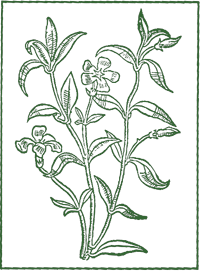This perennial is thought to be among the oldest of cultivated flowers. The word is derived from the French name for the plant, pensée, meaning thought. The pansy of Shakespeare’s time is not the larger modern hybrid, but . . .
 “...in form and figure like the Violet, and for the most part of the same bigness, of three sundry colors, whereof it took the surname Tricolor, that is to say, purple, yellow, and white, or blue.”
“...in form and figure like the Violet, and for the most part of the same bigness, of three sundry colors, whereof it took the surname Tricolor, that is to say, purple, yellow, and white, or blue.”
— John Gerard (1545–1612)
The pansy was also called heart's ease and flower-of-the-Trinity and was given in courtship as an emblem of love.
Some editors have maintained that although she gives rosemary and pansies to Laertes, Ophelia intends them as tokens of love for Hamlet, for whom, in her distraction, she has mistaken her brother.